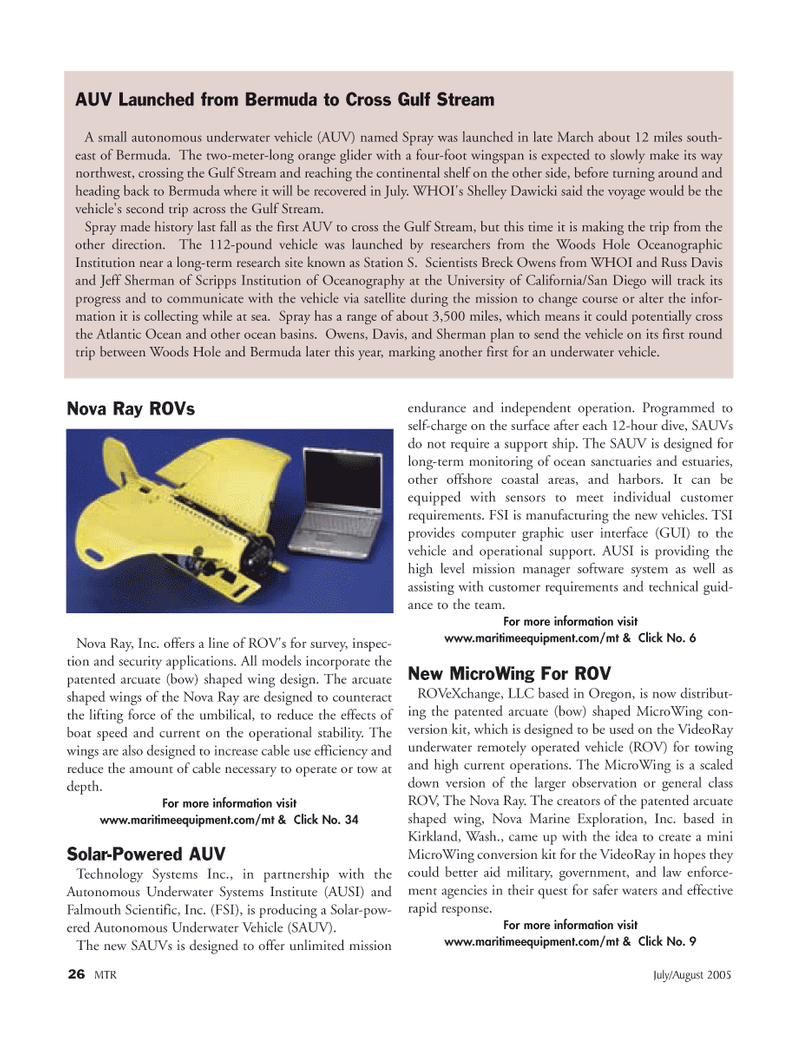
Page 25: of Marine Technology Magazine (July 2005)
Read this page in Pdf, Flash or Html5 edition of July 2005 Marine Technology Magazine
26 MTR July/August 2005
Nova Ray ROVs
Nova Ray, Inc. offers a line of ROV's for survey, inspec- tion and security applications. All models incorporate the patented arcuate (bow) shaped wing design. The arcuate shaped wings of the Nova Ray are designed to counteract the lifting force of the umbilical, to reduce the effects of boat speed and current on the operational stability. The wings are also designed to increase cable use efficiency and reduce the amount of cable necessary to operate or tow at depth.
For more information visit www.maritimeequipment.com/mt & Click No. 34
Solar-Powered AUV
Technology Systems Inc., in partnership with the
Autonomous Underwater Systems Institute (AUSI) and
Falmouth Scientific, Inc. (FSI), is producing a Solar-pow- ered Autonomous Underwater Vehicle (SAUV).
The new SAUVs is designed to offer unlimited mission endurance and independent operation. Programmed to self-charge on the surface after each 12-hour dive, SAUVs do not require a support ship. The SAUV is designed for long-term monitoring of ocean sanctuaries and estuaries, other offshore coastal areas, and harbors. It can be equipped with sensors to meet individual customer requirements. FSI is manufacturing the new vehicles. TSI provides computer graphic user interface (GUI) to the vehicle and operational support. AUSI is providing the high level mission manager software system as well as assisting with customer requirements and technical guid- ance to the team.
For more information visit www.maritimeequipment.com/mt & Click No. 6
New MicroWing For ROV
ROVeXchange, LLC based in Oregon, is now distribut- ing the patented arcuate (bow) shaped MicroWing con- version kit, which is designed to be used on the VideoRay underwater remotely operated vehicle (ROV) for towing and high current operations. The MicroWing is a scaled down version of the larger observation or general class
ROV, The Nova Ray. The creators of the patented arcuate shaped wing, Nova Marine Exploration, Inc. based in
Kirkland, Wash., came up with the idea to create a mini
MicroWing conversion kit for the VideoRay in hopes they could better aid military, government, and law enforce- ment agencies in their quest for safer waters and effective rapid response.
For more information visit www.maritimeequipment.com/mt & Click No. 9
AUV Launched from Bermuda to Cross Gulf Stream
A small autonomous underwater vehicle (AUV) named Spray was launched in late March about 12 miles south- east of Bermuda. The two-meter-long orange glider with a four-foot wingspan is expected to slowly make its way northwest, crossing the Gulf Stream and reaching the continental shelf on the other side, before turning around and heading back to Bermuda where it will be recovered in July. WHOI's Shelley Dawicki said the voyage would be the vehicle's second trip across the Gulf Stream.
Spray made history last fall as the first AUV to cross the Gulf Stream, but this time it is making the trip from the other direction. The 112-pound vehicle was launched by researchers from the Woods Hole Oceanographic
Institution near a long-term research site known as Station S. Scientists Breck Owens from WHOI and Russ Davis and Jeff Sherman of Scripps Institution of Oceanography at the University of California/San Diego will track its progress and to communicate with the vehicle via satellite during the mission to change course or alter the infor- mation it is collecting while at sea. Spray has a range of about 3,500 miles, which means it could potentially cross the Atlantic Ocean and other ocean basins. Owens, Davis, and Sherman plan to send the vehicle on its first round trip between Woods Hole and Bermuda later this year, marking another first for an underwater vehicle.
MTR#1 (17-32).qxd 7/19/2005 10:00 AM Page 26

 24
24

 26
26
